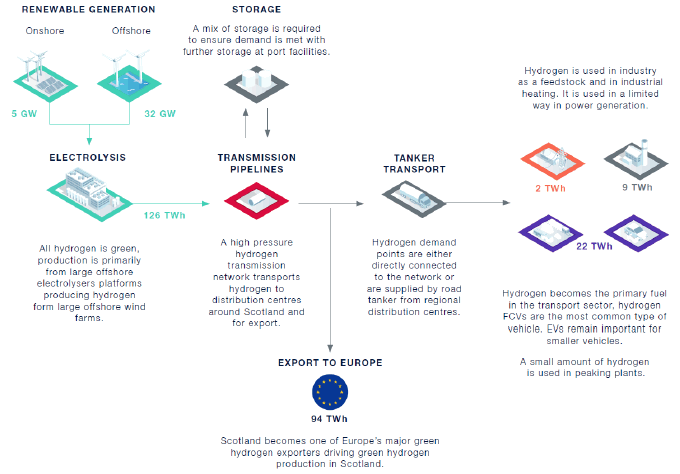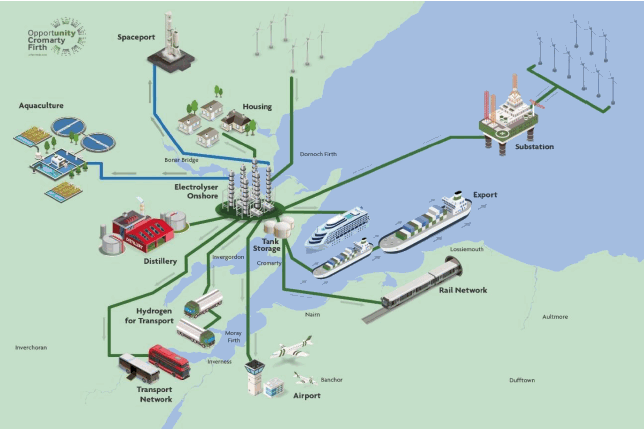Scottish Government Hydrogen Policy Statement
We set out our vision for Scotland to become a leading hydrogen nation in the production of reliable, competitive, sustainable hydrogen, securing Scotland’s future as a centre of international excellence as we establish the innovation, skills and and supply chain to underpin our energy transition.
Chapter 9. Hydrogen for Trade
Policy Priorities: Hydrogen for Trade
Our vision is to establish Scotland as a 'Hydrogen Nation' that is recognised internationally for its expertise and capacity.
We will actively seek international collaboration in the development of our shared hydrogen economy and fully explore our hydrogen export potential.
We will fully explore the opportunities Scotland has to establish a new industry around the export of renewable hydrogen.
Scotland's Enterprise Agencies
Scotland's enterprise agencies: Scottish Enterprise, South of Scotland Enterprise, Highlands and Islands Enterprise and Scotland Development International, recognise that hydrogen is a significant economic opportunity for Scotland and are developing strategic programmes of activity to align with the Scottish Government's hydrogen policy position and Hydrogen Action Plan on its publication.
We will continue to work closely with our enterprise agencies to support the development of a strong pipeline of innovative projects and engagement with supply chain, industry and academia to maximise the economic potential of a future hydrogen industry in Scotland.
Scotland's place in the international hydrogen economy
Scotland has sufficient scale of renewable generation potential to meet domestic needs and to simultaneously satisfy the import requirement of others, thereby playing a key role in the creation of a European hydrogen market.
Based on the finding of the Hydrogen Assessment, we expect the conditions in Scotland to suit the large-scale production of low-cost hydrogen for export and for this to be a feature of our energy landscape in the future.
Europe has an ambitious Hydrogen Roadmap,[16] and a number of countries have recently published hydrogen strategies. Countries such as Germany, which has declared it will need 90-110TWH and that its planned 5GW of domestic production could meet 14TWh of this. France and the Netherlands already have well developed plans to use hydrogen to decarbonise their heavy industries, for conversion of their gas networks and to build new distribution infrastructure to transport that hydrogen by pipe, truck and by ship.
Scotland is well placed in terms of proximity and infrastructure connectivity to several European import nations, such as Germany, the Netherlands, Belgium and Sweden, that are unlikely to be able to decarbonise wholly through their indigenous wind and solar renewable energy supply. As large demand for green hydrogen develops in Europe, our challenge is to ensure Scotland becomes a primary centre of production to meet this need.
Our vision is for Scotland to become a Hydrogen Nation that is able to produce reliable, competitive, and sustainable renewable hydrogen and is recognised as a centre of international excellence as we establish the innovation, skills and supply chain that will underpin our energy transition.
We believe Scotland's unique selling points, including its natural resources, infrastructure and skilled energy workforce, could enable us to become a producer of low-cost hydrogen in Europe by 2045. We are intent in developing our hydrogen capabilities as part of Europe, and as part of the European system that is now being actively pursued.
The Scottish Hydrogen Assessment considers in detail a broad range of scenarios, including one whereby Scotland becomes a centre for hydrogen production in Europe, exporting hydrogen across the rest of Europe and beyond.
If this ambition is to be realised, a significant ramp up in production of green hydrogen will be required as envisioned in this policy statement. The Hydrogen Assessment estimates that by 2045 Scotland could produce 37 GW of renewable generation producing 126TWh of renewable hydrogen, of which 94 TWh are produced to supply export demand. See figure B.
Figure B Scottish Hydrogen Assessment Report. Scenario: Green Export in 2045caption

Hydrogen can be transported in the same way as natural gas, via pipelines or vehicles, and wider imports and exports will need supporting port facilities and shipping vessels. We will therefore consider the infrastructure needed at our ports and harbours to support the transportation of gases including hydrogen and CO2.
We are also working with partners on research to explore the safe and cost-effective options for the marine transport of hydrogen between Scotland and the UK and European ports. This work will evaluate the various Liquid Organic Hydrogen Carrier (LOHC) options to facilitate the large scale transport and storage of hydrogen.
International engagement and sharing expertise
Scotland's Energy Strategy recognises the importance of working with international partners to better understand the transition to a net zero economy. International engagement on hydrogen is a particular priority for Scottish Government, with international activity on hydrogen growing at pace in Europe and further afield. Scotland is the co-chair of the Under2 Coalition Industry Transition Platform, leading work on achieving a low carbon industry future via disruptive innovation and sustainable hydrogen.
Working with some of our overseas Hubs, we have acted promptly to ensure Scotland is engaged in the developing hydrogen economy. We are particularly interested in demonstrating Scotland's potential for green hydrogen export, our supply chain expertise and possible areas for collaborative development and future cooperation. These areas include sharing our expertise and learning from the many Scottish hydrogen projects to date, integrating different parts of the system as they develop, and providing an international centre for testing.
The emergence of hydrogen within the energy transition is part of a once-in-a-generation whole system change. Therefore we want to work with others on the development of the whole hydrogen value chain - within Scotland, within Europe, and making connections globally. This is an extension of Scotland's role as a global climate change leader, underlined by our absolute commitment to respond to the climate emergency and our statutory target of net zero greenhouse gases by 2045.
We want to work with others in mapping the full length of the supply chain from the multiple geographic energy sources and from hydrogen production, through local use, storage and transport, to where the bulk of hydrogen will ultimately be used. We recognise that this is a large complex system that will need to involve North Sea and continental pipeline systems, as well as shipping routes in northern and southern Europe, decisions on transit technology, and applications that range from the small scale and local to the large-scale industrial.
We also recognise there are a number of drivers that determine which countries are selected as import partners. We appreciate that there is a strong and valid international development dimension in some cases – which we would support. However, looking at the whole system, Scotland has a crucial contribution to make based on our resources; proximity to norther Europe; pipeline infrastructure; experience; and advanced stage of development in many areas.
Where there will be some change in the countries that are net energy producers, and many of Europe's new partners will need undergo a stage of extensive development, Scotland is one of the few countries that will be able to maintain its role as a net energy exporter, building on its 45-years of experience with oil and gas. We have already started the successful transition from oil and natural gas to offshore wind and hydrogen.
We know we're in a time of transition – which is why our Learning by Doing approach is so appropriate. We're keen to share our experience and to learn and work with others so that together we can develop the new hydrogen economy more efficiently, quickly, systematically and effectively.
Inward Investment and Export Opportunities
Shaping Scotland's Economy, Scotland's Inward Investment Plan[17] was published on 27 October. It sets out our ambitions for Scotland as a leading destination for inward investment aligned with our values as a nation. Our strategic approach focuses on opportunities where Scotland can demonstrate an international comparative advantage mapped to strong global demand. The nine opportunity areas for focus identified include Energy Transition.
The Scottish Government is already working hard to support domestic businesses in light of the challenging operating environment as a result of the COVID19 pandemic with a package worth over £2.3bn. Inward investment complements such domestic investment due to a strong positive relationship with productivity, innovation and trade. It helps to transfer skills, support local supply chains and spur exports, creating a more open and outward facing economy.
Next steps
Producing the quantities of hydrogen required to support our domestic and export ambitions will be a challenge and will require significant amount of offshore wind deployment and electrolyser capacity. All indications are that this is feasible, though it will require further research and clear frameworks to make it happen.
If Scotland is to supply hydrogen at a low cost to compete with other potential hydrogen exporters, such as North Africa and South America, we will need to establish quickly what the price of hydrogen from Scottish offshore wind could be. This and building links with potential export markets will be the focus of further work.
We will continue to work with our enterprise agencies to ensure benefits from the growth in a hydrogen export market are captured for our domestic supply chain. This includes extensive engagement at strategic, sectoral and company level, promotion of Scotland's potential, and making Scottish companies aware of international opportunities in the hydrogen supply chain where these arise.
The Scottish Hydrogen Action Plan will focus on support for low-cost renewable hydrogen production and supply chain development at this early stage in order to accelerate deployment, build market position and enable more of the value chain to be captured in Scotland.
Case study – North of Scotland Hydrogen
North of Scotland Hydrogen is a series of scalable green hydrogen projects based in the Cromarty Firth which will produce hydrogen from renewable energy for regional, national and export use. The Highlands is rich in renewable energy; producing more renewable energy for our country than any other region, and this energy can be used to meet Scottish Government's net zero obligations. The initial North of Scotland Hydrogen project will supply green hydrogen to distilleries in the region. It is a partnership between Pale Blue Dot Energy, Port of Cromarty Firth, Scottish Power, Glenmorangie and Whyte & Mackay. These distillers operate a number of distillery sites in the region and are keen to develop 'net zero' whisky for their customers around the world.
Future projects include the potential to decarbonise wider regional hydrogen transport applications, the decarbonisation of heat and industrial use in the north of Scotland (Invergordon sits strategically at the end of the gas grid,) and the potential for hydrogen export to other regions and countries, particularly Germany and the Netherlands. Port of Cromarty Firth is working with regional and national partners including HITRANS, The Highland Council, SGN and others, to realise the full potential from this opportunity and to position Scotland as global leaders in green hydrogen technologies. North of Scotland Hydrogen will create exciting skilled careers and business opportunities, and the technology and expertise developed will be exported around the world for many years to come, as other countries take action to meet their own climate targets.

Contact
Email: onshoreoilandgas@gov.scot
There is a problem
Thanks for your feedback